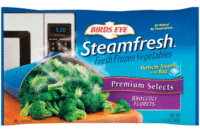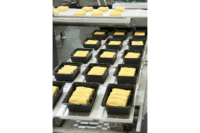
People might say you need to “blow off some steam” when things get rough. But no matter what, you’d be hard pressed to find any processors just “blowing off” steam. That’s because steam-cook packaging is helping fuel growing microwavable food sales, which are expected to reach $75.4 billion by next year, according to a study by Global Industry Analysts Inc. (GIA), San Jose, Calif. Consumer demand for convenient, high-quality, time-saving meal solutions is helping to drive this uptick and, experts say, steam-cook packaging plays an important role.
GIA data indicate that frozen foods account for the majority of the microwavable market - 80.8 percent in 2008. In the U.S. alone, chilled microwavable foods raked in an estimated $2.2 billion last year. And it would be a logical conclusion that much of this came from steam-cook packaged food sales.
In fact, more than 150 frozen and/or chilled new microwavable steam-cook products were launched in 2008, according to Mintel’s Global New Product Database, Chicago.
Refrigerated & Frozen Foods caught up with packaging suppliers on the cutting edge of the microwave steam packaging world to gain insight into this growing sector.
Weighing in are: Shirley Cox, president, Healthy Fx, Allison, Ont., Canada; Rudi Kleer, new products manager, PPI Technologies Global, Sarasota, Fla.; John McCurdy, business development manager Alcan Packaging Food Americas, Chicago; and Kristy Ng, assistant manager overseas business, ZipnVent, Hong Kong.
Refrigerated & Frozen Foods: What are the advantages of steam-cook packaging for food preparation?
Shirley Cox: Microwave steaming is the most energy efficient and healthiest way to prepare foods. It is a proven fact that the lesser amount of time a food has to be cooked, the more minerals and vitamins are retained. Therefore, if you can combine the speed of the microwave with the positive effects of a true pressure release package then you have the benefit of both speed to cook and retaining the vitamins and minerals that would have been lost to the atmosphere with a conventional microwave cooking method.
Rudi Kleer: [Microwave steam packaging provides] portion control. Steam cooking with our SmartDevice valve allows for even cooking throughout the container; it’s ideal for take-out meals from restaurants and for commissaries. Meals can be packed and eaten in various locations with the same results.
John McCurdy: It is a combination of advantages. There are convenience benefits as well as what some believe to be nutritional benefits. Microwave steaming, in package, can’t be beat with respect to ease of preparation and clean-up.
Kristy Ng: There are several advantages of microwave steam cooking. For example it can retain more nutrients then cooking in boiling water and it retains natural texture and colors. It also can keep the food moist, tasty and juicy. If consumers fried food with oil using traditional pots and pans, it will harm health as well because food cooked in fat will increase … cholesterol.
R&FF: How has microwavable steam packaging changed?
Cox: There is far more selection of technology. The steam cooking area is exploding with steaming becoming the most convenient and nutritious way to cook gourmet meals and sides with little or no clean-up required for our time-starved consumers. … A look at the past and television shows like Star Trek and the one button pushing meal preparation and you will realize that time is here and has been for awhile. The consumer not only wants more but they expect it and demand it.
Kleer: More and more packages have become available and the consumer is now becoming aware of the advantages of steam cooking in the microwave. Microwave ovens have become more powerful and intelligent making it easier for the consumer to try out new products.
We see a lot of packages appearing in the supermarkets that are eye catching and provide the consumer with a variety of ready-to-eat meals. These packaged range from rigid trays to stand-up pouches. There is a wide range of vegetable products that have appeared recently, as well as a variety of seafood products.
McCurdy: There is a lot more consumer demand and awareness of convenience and product quality. These new technologies help deliver quality and convenience, opening up new applications for food manufacturers.
Explosive growth in steam-in packaging has been driven by conversion of the vegetable category. It has had the effect of energizing the category, bringing consumers back and creating new opportunities in snacks and appetizers.
There also has been increased consumer interest in ethnic products that benefit from steam-in, for example dumplings (pot stickers) and tamales.
Ng: Over the last decade, microwavable packaging has merely been widely used for reheating ready food or meals rather than cooking or even steam cooking raw food. The innovation of microwavable steam cook packaging has changed from packaging only to cookware for busy consumers.
Busy consumers are demanding higher quality products, easy-to-use packaging and more efficient cooking methods. They no longer sacrifice the taste and nutrition value of food for convenience. Packaging manufacturers therefore have to develop safe, easy-to-open, healthy and vitamin-preserving packaging solutions to cater to customers’ needs.
R&FF: What are food processors or foodservice operators looking for from steam-cook packaging?
Cox: In all honesty, it seems that price is the only factor nowadays. As packaging quality, if it is recyclable or if it retains more minerals, vitamins and moisture, or gives consumer a superior product line, doesn’t seem to come in the bottom line decision.
Kleer: We supply the packaging and machinery components for our FastFine Cuisine program. Speed and versatility are essential and our machines are designed for start-up and production requirements.
McCurdy: Processors are always looking for shelf appeal and consumer convenience. They are also looking for good ways of doing line extensions and enhancing their brands.
Ng: They are looking for some packaging which can absolutely provide benefits to food items during the cooking process. Also their ideal package should be used in fast, convenient and simple ways for consumers. However, they prefer not to modify their existing machines in order to lower the production cost.
R&FF: What’s next in microwavable steam-cook packaging?
Cox: The sky is the limit. In my opinion the next step would be to “green” up the packaging, make sure they put the proper recycling symbol on each of the parts of the packaging and, if possible, create a closed loop system and source from post-consumer materials for packaging. Consumer convenience combined with earth friendly practices make sense as cooking in the microwave is the most energy efficient, time-saving, widely-used appliance out there today. The market is still in its infancy stages with potential to grow for years to come.
Kleer: New recipes will be developed that will appeal to a broader spectrum of the population. Packages will have SmartLabels that will “talk” to the microwave regarding freshness, cooking times, etc.
More ethnic foods will appear in these packages and institutions will realize the savings that these packaged will bring - cook on time, less waste, specially developed meals for diabetics, etc.
Green trays will also start making their appearance and consumers will become more educated and exposed to the advantages of new packaging ideas and trends.
Multi-compartment pouches will become more prevalent as consumers want more versatility in their meals - sauce in one compartment and the main meal in the other compartment.
McCurdy: Steam-in will move beyond typical frozen vegetables and be utilized in different products such as snacks, appetizers and proteins.
Ng: A vacuum pack that can be steam cooked in a microwave will most likely be the next innovation on the market. The technology of vacuum packaging with a venting feature is a unique process and requires skillful knowledge - the contrast between vacuum packaging with venting causes tremendous difficulties in releasing and vacuuming vents and gas concurrently.
New and improved
What are suppliers’ latest microwave steam-cook offerings? R&FF went straight to the source …
Healthy Fx’s Shirley Cox: We have a three-in-one bag. It pressure/steam cooks in the microwave, is an airtight storage bag before cooking and can also be used as a preservation bag for fresh vegetables like carrots, celery and potatoes.
It was launched in December 2008. These bags can be used for consumer sales and also are perfect for take-out and ready-to-go-meal areas of stores. Labels can be attached to the bag for pricing. The bags can also be made from fully recyclable materials.
PPI Technologies’ Rudi Kleer: We launched the SmartDevice valve in 2002 with a specially developed film and tray combination. The product (food) is placed in a specially developed tray that is ideal for the microwave. The SmartDevice lid is placed over the tray and the lid is sealed and trimmed to the shape of the tray.
The SmartDevice valve opens under pressure, releases the steam under control and as the pressure drops, the valve closes.
Applications include frozen vegetables, frozen fish (salmon, shrimp, etc.), combo meals, chicken with rice or pasta. We have a whole range of recipes for our FastFine Cuisine program that can be licensed to people who buy our system.
Alcan Packaging’s John McCurdy: We released SteamRight in September 2008. It combines steam-venting with an easy-open, laser-scoring feature, making it a fast, clean and easy package to use. It is a flexible package that works well with frozen meals, different types of side dishes, snacks and appetizers.
It is a two-for-one. With SteamRight, you get a combination of features. SteamRight provides ease and speed of steaming with a laser-scored, easy-open feature.
ZipnVent’s Kristy Ng: The ZipnVent Microwave Steaming bag was developed by our company founder and R&D team in 1999. Now it is broadly applied in microwave packaging. Examples of ready meal applications include fresh and frozen vegetables, seafood packed in tray or bag form, pasta, meat, poultry, etc.
We can produce different kinds of food packages in various formats for example: top seal lidding film for trays, stand-up pouches with or without zippers, center sealed bag, etc.
We are able to control the pressure level inside the package by applying different sizes of leasing vents.




